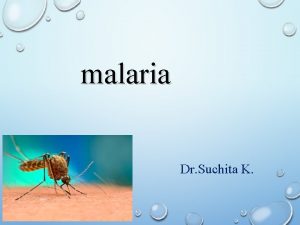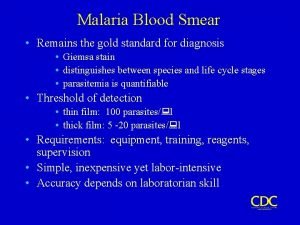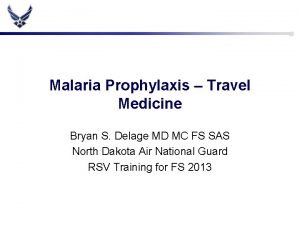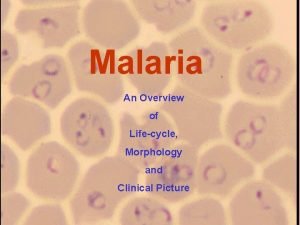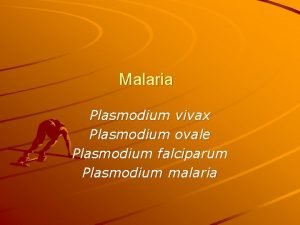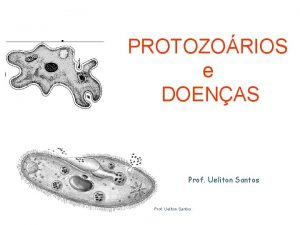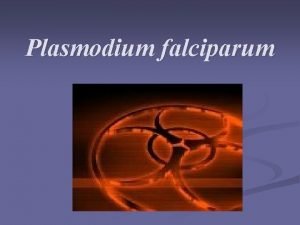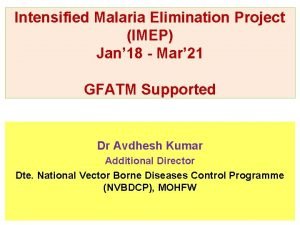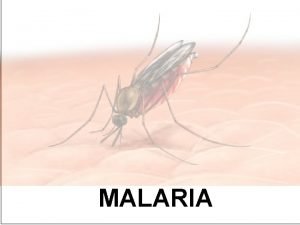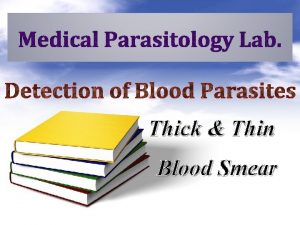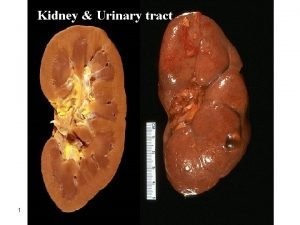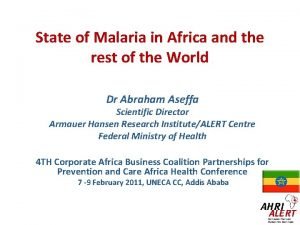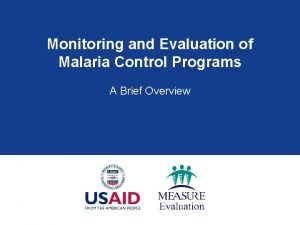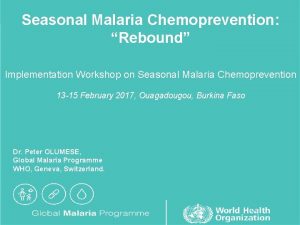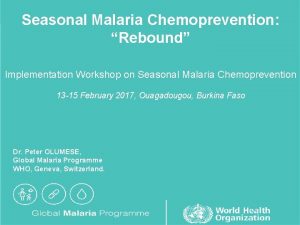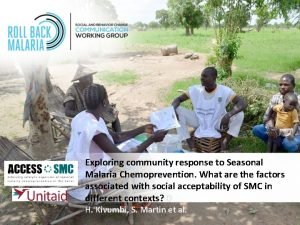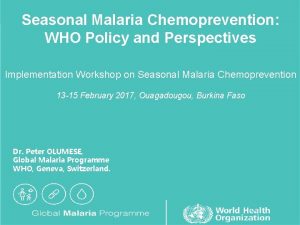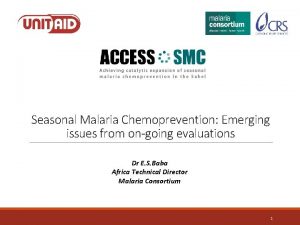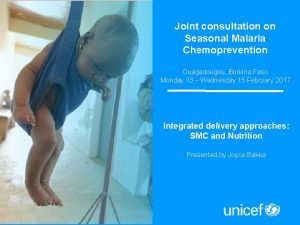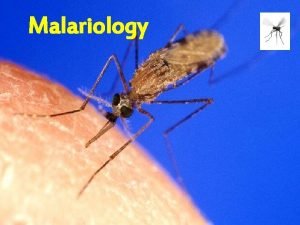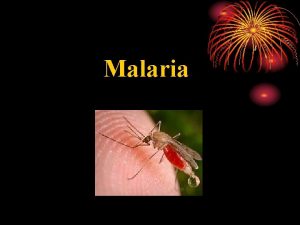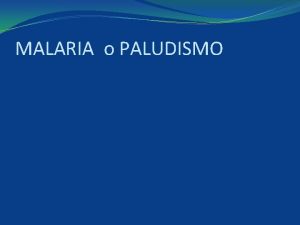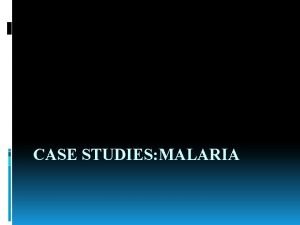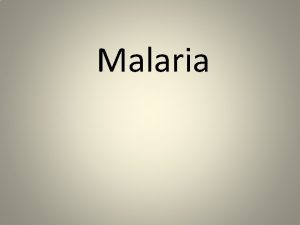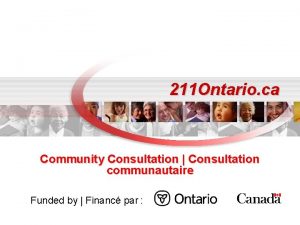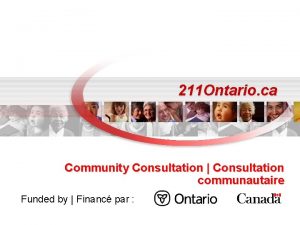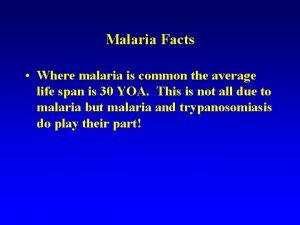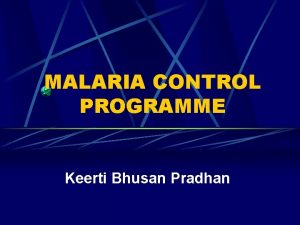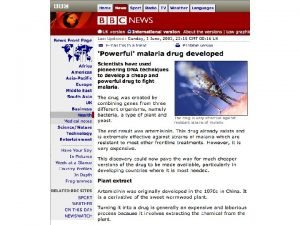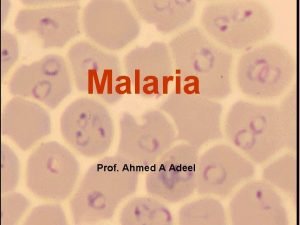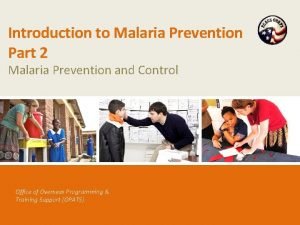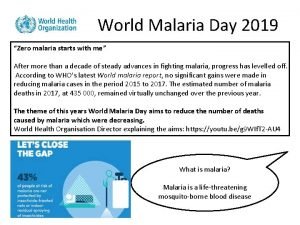COMMUNITY ACCEPTANCE OF SEASONAL MALARIA CHEMOPREVENTION Joint Consultation

























- Slides: 25

COMMUNITY ACCEPTANCE OF SEASONAL MALARIA CHEMOPREVENTION Joint Consultation on SMC 13 -15 February, 2017 Ouagadougou, Burkina Faso

Common Vision: Role of communications for SMC. • Fostering country and community ownership • Reducing risks of misunderstanding and negative perceptions • Ensuring adherence to SMC dose completion Source: http: //www. who. int/malaria/publications/atoz/9789241 504737/en/ (page 18)

Within ACCESS SMC, We Aimed to Build TRUST • leadership and communities are informed and mobilized to support and participate, i. e. come to distribution points/allow distributors in their homes and accept SMC medicines (safe, easy and effective) Manage EXPECTATIONS • stakeholders, communities and caregivers understand/value what SMC medicines can do (and not do) and how SMC campaign is delivered (distribution mode) Ensure ADHERENCE • caregivers understand how and when to administer SMC to their eligible children, including how to manage fever or side-effects after taking the medicines

2 Pronged Approach. Mass Media Awareness at stakeholders and community level of SMC, its purpose, and availability. Contribute in building momentum around malaria control in each country. Ensure SMC is shown as a complementary intervention to existing malaria control strategies Through: – Community Radio PSAs – Video on SMC – Media toolkit and training for communitybased stations Community Sensitization Build trust for SMC at the community level primarily though interpersonal communication Ensure uptake of SMC. Promote local ownership of SMC Through: – Community fora – Interactive radio shows – Social mobilization events

“The How” 5 Pillars. 1. Coordination at country and sub-country levels 2. Advocacy 3. Social mobilization before and during campaigns Harmonised malaria messaging Support and local ownership High uptake 4. Behaviour change communication Malaria prevention & management behaviours increase/maintenance 5. Monitoring, Evaluation and Research Improved communications’ programming

KABP Study conducted in Mali, Niger, Guinea & The Gambia

KABP Study Objective Period: 2016 Study Objective: • To evaluate the knowledge, attitudes and practices of the community on seasonal malaria chemoprevention and factors affecting the uptake of the intervention. • To provide a technical basis to formulate and implement a sustainable, and community-friendly communications strategy for SMC scale up.

Methodology • Mixed methodological approach with a quantitative component in which 2 400 households (600 per country) were interviewed and a qualitative component with focus groups and in-depth individual interviews. • Respondents: • • Primary: Mothers & caregivers Secondary: Heads of households Tertiary: Community workers & Opinion leaders Meso: Healthcare workers, SMC focal points, Nurses & Doctors

General Knowledge on Malaria Connecting with Communities.

Malaria Transmission, Prevention Methods & Symptoms • Overall, populations do associate malaria to mosquito bites with close to 100% in Niger and 98, 5% in Guinea. • Mosquito nets and environmental sanitation remain the best known malaria prevention methods. More than 90% of mothers and caregivers interviewed cite the use of mosquito nets as a prevention method. • Malaria symptoms are also well known by mothers and caregivers. The most cited symptoms are fever (94, 5% in Guinea, 88, 2 in The Gambia, 96, 7% in Niger & 90, 1% in Mali), headaches and vomiting.

Care Seeking Behavior Guinea: • 47. 6% of caregivers consult the day after the first symptoms. Only 38. 3% take their child to a health facility at the first signs of malaria. The Gambia: • The rate of use of health facilities in the first 24 hours after symptoms appearance is high (78. 8%), especially in Central River Region (82. 5%). Mali: • Nearly six out of ten mothers and caregivers go to a health center within 24 hours after the first symptoms of malaria. However, more than one parent in ten uses traditional healers in general as well as in malaria. Two out of ten people consulted a traditional healer in the 6 months preceding the survey. Niger: • 83, 7% of mothers and caregivers go to a health center in the first 24 hours following the first symptoms.

Acceptability of Seasonal Malaria Chemoprevention.

Knowledge on SMC Item The Gambia Guinea Mali Niger Beneficiari es 77, 2% of mothers & caregivers know that SMC targets children aged between 3 to 59 months 93% of mothers & caregivers know that SMC targets children aged between 3 to 59 months 84% of mothers & caregivers know that SMC targets children aged between 3 to 59 months 94% of mothers & caregivers know that SMC targets children aged between 3 to 59 months Goal 94, 7% of mothers know that SMC protects children from malaria 86, 1% of mothers know that SMC protects children from malaria 72% of mothers know that SMC protects children from malaria 98, 8% of mothers know that SMC protects children from malaria 82, 1% know that the treatment is administered over 3 days during each cycle 85% know that the treatment is administered over 3 days during each cycle 98, 8% know that the treatment is administered over 3 days during each cycle 25, 8% of mothers responded that SMC protects children during one month 60, 2% of mothers responded that SMC protects children during one month Treatment Protection NR 52, 6% of mothers responded that SMC protects children during one month NR

SMC Awareness During the study, most respondents had already heard of SMC, over 80% in all countries except in Mali where 60% of the respondents knew of the campaign. The Gambia Niger Guinea Mali 59. 9% 90. 7% 19. 5% 17. 8% 9. 3% Yes 40. 1% 80. 5% 82. 2% No

Drug Preparation & Administration Niger Guinea I dissolve the drug in water 51. 7% I mix the drug with sugar 51. 4% I follow the health worker's advice I crush the drug I don't add any water 21. 9% 16. 7% I mix white & yellow pills together 39. 0% I crush the drug and add water 60. 2% 9. 7% Other I make the child swallow the drug 4. 5% Autres 2. 7% 7. 0%

Drug Preparation & Administration The Gambia I dissolve the drug in water and I add sugar I mix the drug with sugar 19. 5% 9. 2% Mali 43. 9% I dissolve the drug in water I crush the drug 27. 1% I mix the drug with sugar 26. 4% 5. 5% The child swallows the drug 13. 7% I make it melt in the spoon and I mix it with sugar 5. 0% No Response The child chews the drug 4. 5% I follow the health worker's advice 2. 2% I make the child swallow the drug 1. 9% The child chews the drug 1. 6% No Response 7. 6% 28. 8%

Intent of Using SMC in the Future Yes No Mali Niger The Gambia No Yes 96, 6% 2, 4% Guinea 99, 8% 0, 2% No Yes 96, 5% 96, 6% 3, 5% 3, 4% No

Barriers to Acceptability. • For mothers & caregivers: Bitter taste of the treatment Mild adverse effects Difficult treatment preparation Treatment administration over several days and 4 cycles and necessary follow up • Limited efficacy duration (28 days) • For fathers: • General sense of fatigue (vaccination campaigns – heavy health calendar) • Confusion with other health campaigns (Polio, MCHWs, LLINs distribution) • Rainy season - planting season – agricultural activities • Mild adverse effects • •

Factors Facilitating Acceptability. • Perceived treatment efficacy • Treatment free of charge • Qualitative information received from community health workers & radios • Door-to-door strategy: • Reinforces/facilitates interpersonal communication • Allows more time with beneficiaries • Builds sense of trust • Community dialogues: • Before cycle: town criers + community leaders (village heads + religious) • During: interpersonal communication + town criers • After: community outreach

Preferred Communication Channels (Interpersonal communication) The Gambia Niger Nurses 54. 6% Town criers 42. 1% 58. 0% Nurses 49. 2% Doctors 41. 7% Community Health Workers 41. 3% Community Health Workers 21. 3% Friends or parents 12. 9% Religious leaders 9. 1% Radio journalists 8. 1% Elected officials, Mayor or political figure 5. 2% Neighborhood Association Members 4. 6% TV journalists 3. 4% Friends or parents 2. 9% Town Criers 2. 4% Others 5. 0%

Preferred Communication Channels (Interpersonal communication) Mali Guinea Doctors 56. 7% Community Health Workers 54. 5% 54. 2% 45. 2% Doctors 51. 7% Nurses 27. 8% Religious Leaders 24. 9% Town Criers Radio Journalists 8. 8% Friends or Parents 7. 7% Teacher Community Health Workers 3. 1% Elected officials, Mayor or political figure 3. 1% TV Journalists 2. 0% Neighborhood Association Member 1. 5% Other 2. 6% 34. 3% Nurses 31. 2% Town Criers 28. 3% Friends or Parents Radio Journalist TV Journalist Religious Leaders 23. 1% 6. 5% 1. 9%

Information Source Before Campaign The Gambia Niger Radio spots 46. 0% Community. . . Town criers 6. 1% Friends/Pare. . . 5. 5% Village Chief 4. 9% Radio spots Friends/Parents Town criers 3. 1% Community Health Workers Local come. . . 3. 1% TV spots Banners/Pos. . . 2. 5% Interpersonal communication Radio shows 70. 4% Town criers 32. 7% Community health workers 30. 8% 31. 3% 9. 2% Home visits Others 64. 2% 20. 2% Radio shows Hospital Guinea 26. 3% 24. 2% 14. 7% 13. 7% 7. 6% Friends/Parents 14. 8% Religious Sermons 13. 8% Radio spots 10. 1% TV trailers 1. 3% Banners/Posters 1. 3% Print 1. 3% Other 0. 9%

Information Source During Campaign Guinée Gambie Des emissions radios Agent de santé communautaire 29. 8% Spots radios Des affichages Des crieurs publics 60. 9% Amis ou parents 5. 3% 14. 1% 6. 8% 26. 6% Emissions radios Des amis ou des parents 24. 8% Agents de santé communautaire Des réunions d’information et d’orientation Agent de santé communautaire Des spots télévisés 1. 4% 1. 1% 2. 0% Des emissions radios Des spots radio Affichages banderoles Autres 26. 4% 14. 6% amis ou parents Des spots radio 65. 0% 50. 5% 45. 3% Des crieurs publics Des amis ou des parents Mali 56. 5% Visistes à domicile Des sermons de prêtres ou d’imams Niger 1. 2% Des causeries éducatives 20. 4% 45. 2% 27. 7% Crieurs publics 21. 8% Spots radio 21. 5% 16. 9% 10. 3% Spots télévisés 6. 2% Bandes annonces à la télévision 4. 4% Causeries éducatives 3. 1% 6. 7% Des bandes annonces à la. . . 2. 2% Des réunions d’information et. . . 2. 0%

Decision-Making Process Neighbors/Friends Husband's brothers Grand-parents/In-laws Mothers, Fathers & Caregivers Without appearing central, women play a decisive role. They ring the alarm since they are the child's primary caregiver, the ones who spend the most time with the child. Fathers also play a key role in terms of care seeking as they cover the costs.

COMMUNITY ACCEPTANCE OF SEASONAL MALARIA CHEMOPREVENTION Fara. ndiaye@speakupafrica. o rg +221 77 332 88 63
 Joint bank account in joint venture
Joint bank account in joint venture Spool joint vs break joint
Spool joint vs break joint Lamb carcass grading
Lamb carcass grading Luschka's joints
Luschka's joints Fibrous joints
Fibrous joints Types of joining methods
Types of joining methods Malaria in pregnancy definition
Malaria in pregnancy definition Gold standard for diagnosis of malaria
Gold standard for diagnosis of malaria Malaria prophylaxis
Malaria prophylaxis Enlargement of a lymphoid organ in the luq
Enlargement of a lymphoid organ in the luq Sporontocides
Sporontocides Icd 10 malaria tropika
Icd 10 malaria tropika Surveilans terpadu adalah
Surveilans terpadu adalah Malaria ciclo
Malaria ciclo Malaria
Malaria Thin and thick smear
Thin and thick smear Conclusion of malaria
Conclusion of malaria Ifn gamma elisa
Ifn gamma elisa Malaria
Malaria Epidemiological triad of malaria
Epidemiological triad of malaria Imep full form in malaria
Imep full form in malaria Black water malaria
Black water malaria Trypanosoma bruzi
Trypanosoma bruzi Quartan malaria nephropathy
Quartan malaria nephropathy Malaria
Malaria History of malaria
History of malaria






